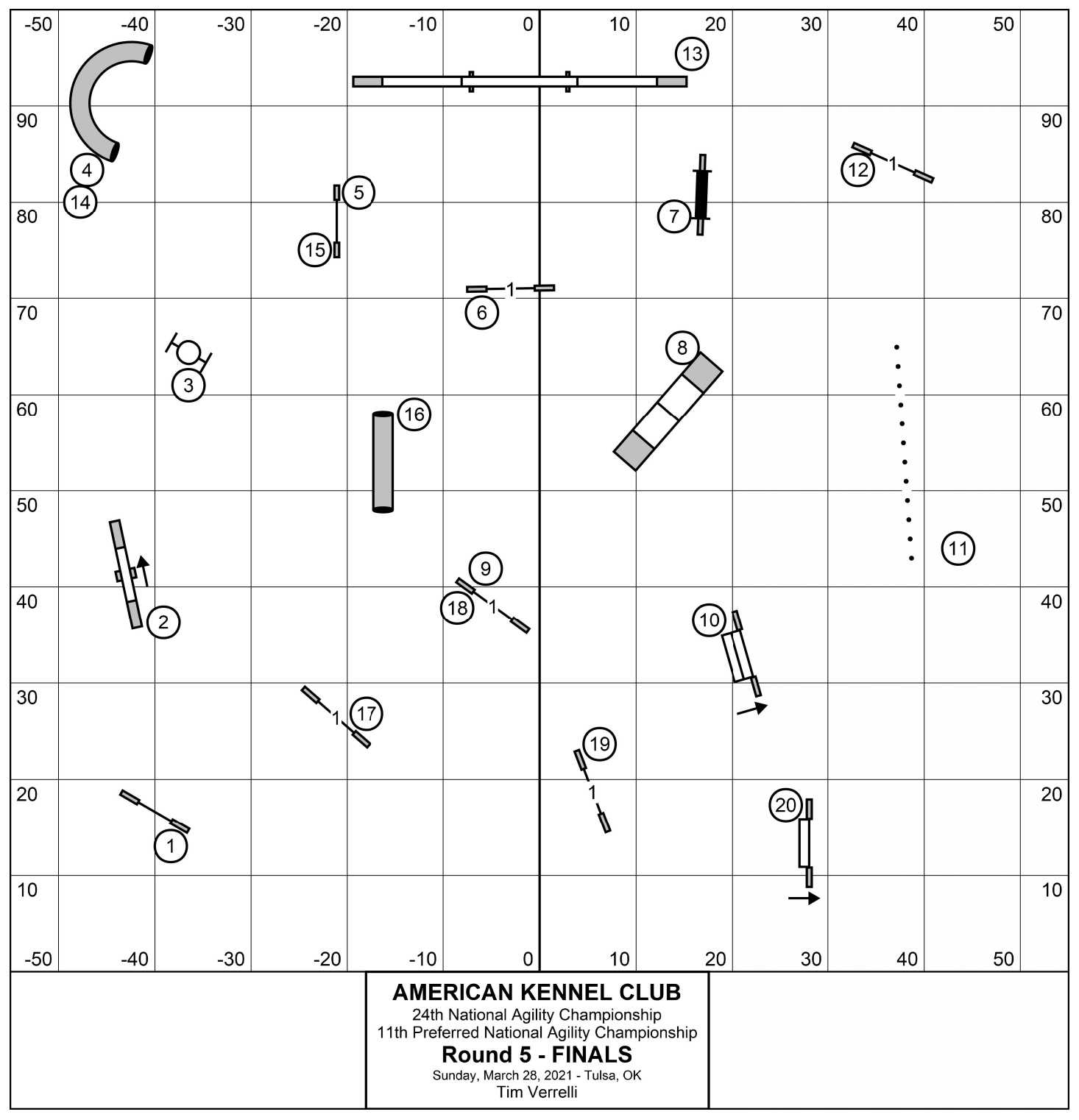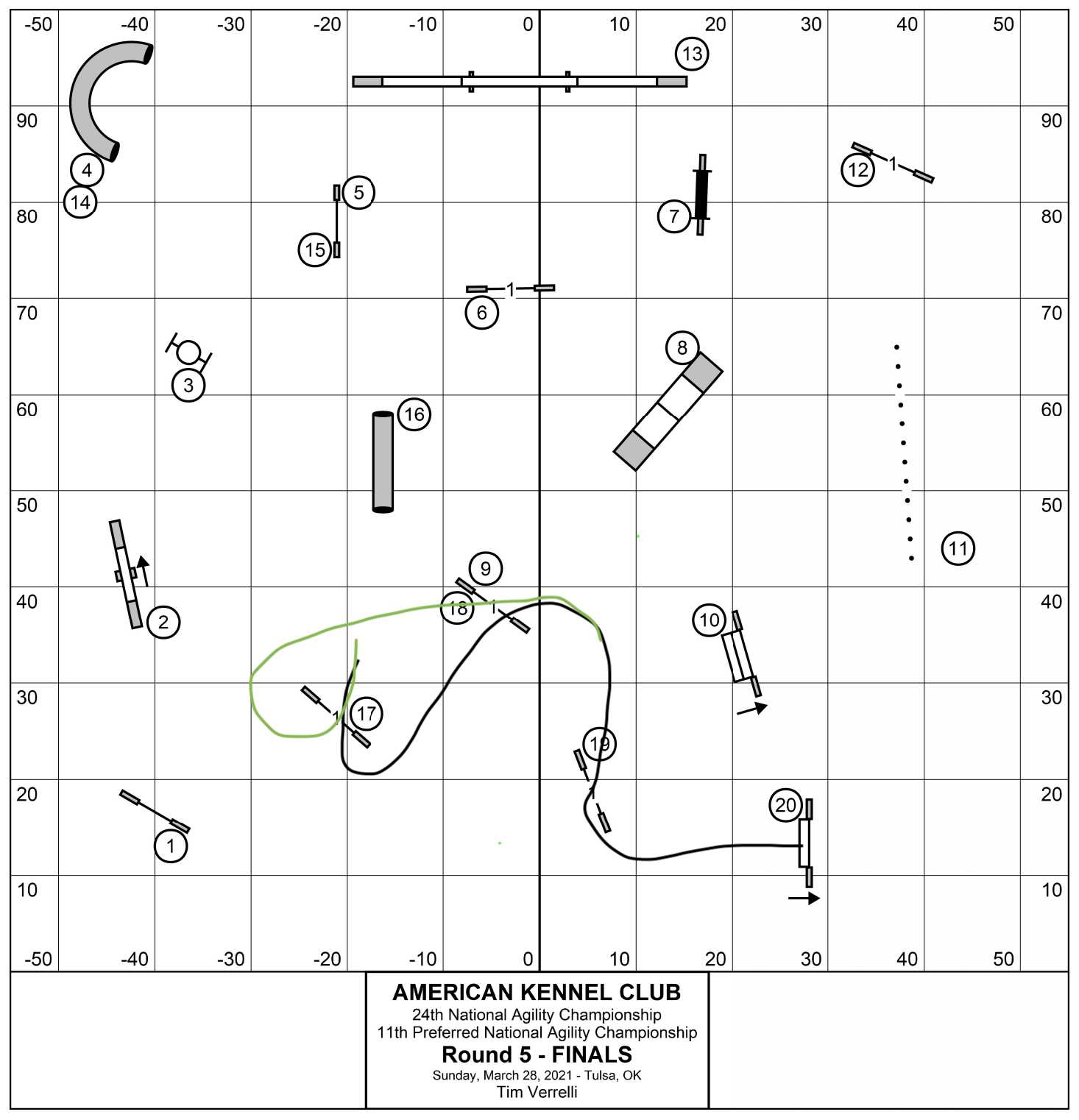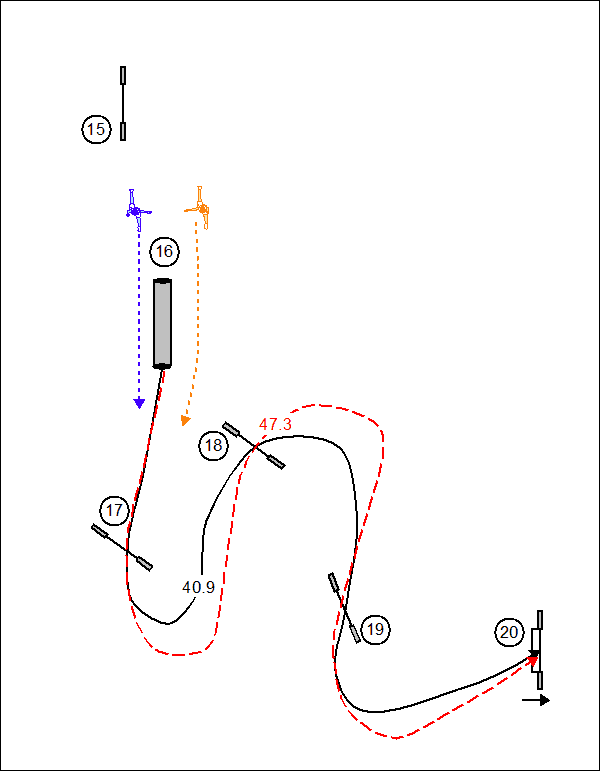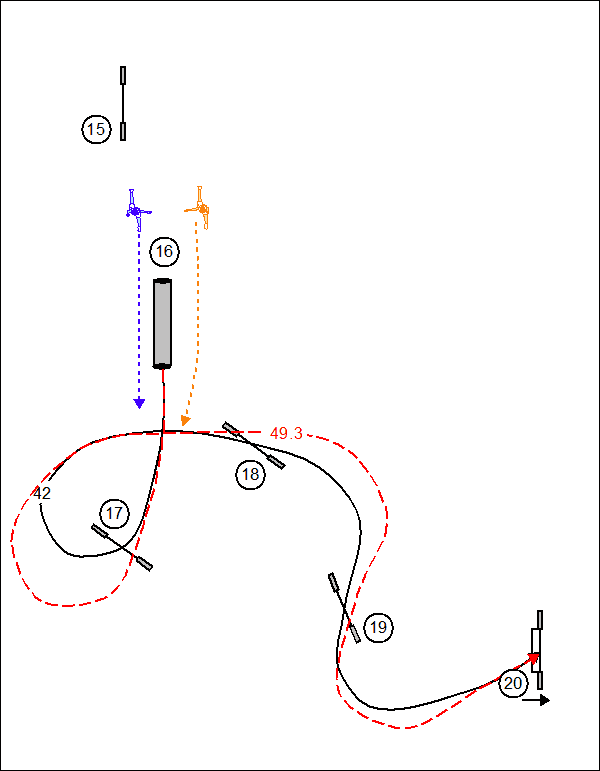Handling the 2021 AKC NAC Finals Closing Sequence
28 May 2021
Update 2021-May-29: I’ve created six practice sequences based on this closing sequence.
There was a lot of discussion online about the fastest line for a dog in the closing sequence of the 2021 AKC National Agility Championship’s Finals round. I liked the design of the course, by judge Tim Verrelli, it featured challenges that you’d see in a weekend AKC course combined with some Premier elements. It seemed like a good finals course: a mix of technical challenges with sections where the fastest teams could show their speed. Though it seemed some of the technical elements were tough for a number of teams.
Here’s the course diagram from the AKC Agility Events website:

Winning Runs
Take a look at these videos to see how the finalists handled the course:
- Jennifer Crank and P!nk winning 16” class (Facebook)
- Jessica Ajoux and Hallelujah winning 20” class (Facebook)
Please send me a link to video of any finalist’s runs and I’ll add them to this article.
How To Handle It?
The three jumps after the tunnel are a Serpentine Serpentine Handling TechniquesSerpentine Sequence shaped like a Pin Wheel with a Jump Wrap Jump Wrap Handling TipsJump Wrap Handling - With VideoJump Wrap/Wrap on the penultimate jump.
The main question was: “which way to wrap the dog over jump 17?“.

The black line, turning the dog to their left at jump 17, effectively treats 17-18-19 as three jump wraps. The dog changes their Lead three times.
The green line, turning the dog to the right at jump 17, requires turning the dog through about a 270 degree turn. But, the dog only changes lead twice and they have a nice line through jump 18 to jump 19.
Snap! and Steve Give it a Whirl
I was able to squeeze most of the course into my 90 x 90 back yard for practice. Firstly, I wanted to see if we could get through it clean (we didn’t: dropped a bar on the triple) and then I wanted to try out the various handling options for the two dog paths. Unfortunately, I didn’t realize my phone ran out of battery and I don’t have any useful video…
As I “preach” in my Backyard Mastery articles, I turned Snap! in both directions on jump 17, then tried almost all the crosses on each of the jump wraps.
There is also a variation I haven’t covered yet in Backyard Mastery, handling from both sides. On this course you could handle tunnel #16 from either side. If I recall correctly, most handlers in the finals ended up with the tunnel on their left because they ended up on the take off side of 15 when handling the preceding tunnel. But handlers could cross on the approach to (or even exit of) the tunnel to put their dog on their right.
Let’s look at turning in each direction in more detail.
Turning to the Dog’s Left
Based on discussions I saw on FB, turning the dog to their left was the most popular handling choice. It is the “obvious” handling and probably has the least risk. Though I don’t know when handlers commented if they were considering they were running “to qualify” or “to win”.
In the diagram below I’ve zoomed in on the course and drawn a black solid line for a “good” dog path through the obstacles and a red dashed line for a kind of worst case dog path. Of course, the true path is very dependent on the size of the dog and the handling used.

As you’ll see below, the ideal path for my imaginary dog turning left is about a yard shorter compared to turning right. Distance-wise the worst case is six to seven yards longer for both turning directions.
The key to handling here is getting a collected turn at 17 with the dog in full extension coming out of the tunnel. For most handlers that would likely mean a front cross Learning the Front Cross - VideoFront Cross at that jump. Though you can also blind cross or decelerate, forward send, and then rear cross Learning the Rear CrossRear Cross.
If this was a training drill you could then wrap jumps 18 and 19 using any combination of the three crosses. Though the fastest handling for most teams will be to handle 18 and 19 staying on the take off side of 18 and “serping” through 19, thereby not crossing on 18 at all. Then either continuing with dog on left through the final jump or blind crossing after 19 to end with dog on right.
Take a look at Snap! and me trying out a lot of handling options in the following video (there are more variations of handling 18-20 in the next video):
Turning to the Dog’s Right
My preference, even before seeing the course run, is to turn the dog to their right at 17. I like the smoother line for the dog from the landing 17 through 19. Though it is even more critical (and can be more difficult) to get a collected turn and in the correct direction at 17 with the dog in full extension coming out of the tunnel.

The black ideal dog path is about a yard longer than turning the other way though you might argue the worse case at 17 could be even worse. LOL!
There is a little potential of getting an off course back into the tunnel but I think “moving in the right direction” should be sufficient. I don’t think Snap! ever looked at the tunnel in the dozens of times we ran this path.
For most handlers, assuming dog on left coming out of the tunnel, that would likely mean a front cross to cue the wrap followed by a blind cross to put the dog on your left. Though, as you’ll see in my video, you can also decelerate, forward send, and then rear cross.
If you start dog on right you can even use a rear cross jump wrap - nice to have in your skills - though it took me a few tries to convince Snap! to decelerate and turn with me behind him!
Once the dog is on the way to 18 the rest of the handling is exactly the same as for turning the other direction.
Take a look at Snap! and me trying out a lot of handling options in the following video:
Conclusions
So which was fastest? Because we ran so many options, over multiple days, and at various levels of intensity it is hard to accurately compare the timings from the videos.
Turning right ranged from 6.2 to 7 seconds from the exit of the tunnel to breaking the plane of the final jump for all the “sensible” handling plans.
I really had to nag Snap! to get a tight turn on 17 and our time was very dependent on how tight that turn was. The fastest approach was decel forward send, front cross, serp 18-19 and blind cross 19.
In general turning right ranged from 6.05 to 6.3 seconds. The fastest two handlings were front followed by blind at 17, serping 18-19 and then continuing the serp to the end with dog on left or blinding again at 19 to put Snap! on my right.
So it looks like my assertion that turning right, even with the longer path, would be faster pretty much worked out. I think it would hold true for most dogs. Big dogs get to run from the landing of 17 through the take off of 19 in nearly full extension.
Small dogs are more likely to have a tight turn on the wrap of 17 and would also benefit from the straighter line of turning right. Though, because they have a shorter stride, they will get to full extension sooner even if they are turned to their left.
The rule of thumb for big dogs is an additional stride takes about 0.3 sec. So the path with the shortest distance is often considered to be the fastest. In general, you want to reduce the number of strides the dog takes. But distance isn’t the only factor.
As you can see from our experience, I’d argue setting the dog’s line so they take as few collected strides (fewer lead changes) can be just as important to getting a fast and winning run.
If we train sequences and spend the time evaluating different handling options, as I’ve been promoting in my Backyard Mastery articles, we can learn what paths are fastest for our team. Then we can confidently use that knowledge in our competition runs.
If you enjoyed this article won't you please:  Thanks!
Thanks!
Related Tags
Related Articles:
- Practice Sequences Inspired by the 2021 AKC NAC Finals
- Flyer and Steve in the 2016 AKC NAC Finals - Video
- Big/Small AKC NAC Inspired Course & Sequences
- Dana Pike Masters Training Sequence - Video
- AKC-like JWW/Premier Novice through Masters Practice Courses
- Fun AKC-like JWW Novice/Advanced Practice Courses
